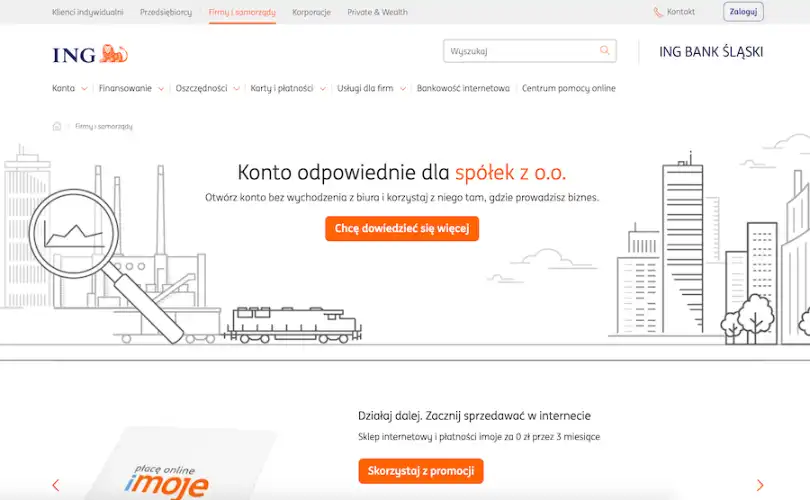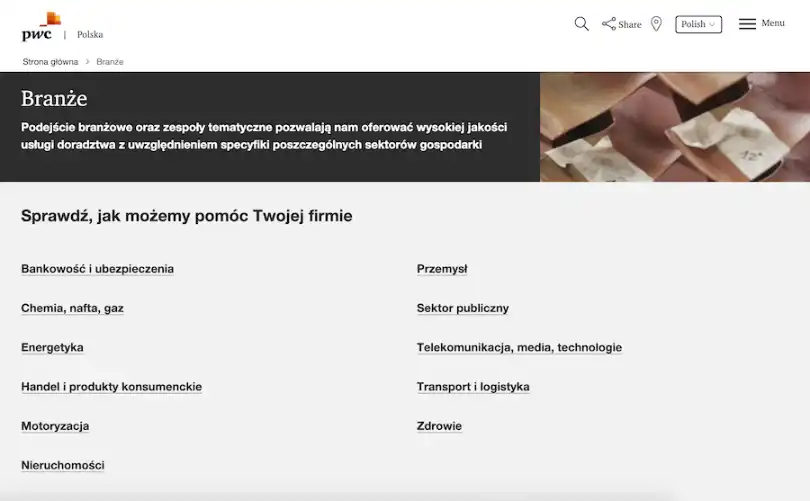This article belongs to the series of texts on how to properly lead B2B sales with a website.
Today I will focus on one aspect — the design of website navigation, taking into account the customer segments for which a company provides its business-to-business services.
You will discover whether B2B customer segmentation directly translates into increased sales and user experience. I will answer the question of what mistakes to avoid and how to improve navigation on a website and increase sales.
A little reminder. B2B — what is it? It's sales between companies (B2B, business to business). B2C, business to customer, is sales from manufacturer to individual customer.
Segmentation and navigation on a website
If you're running B2B sales, I will use a simple example from life.
I recently changed the corporate account of a limited liability company. The thing is that I like to have a clear and friendly interface of a transaction system, and Raiffeisen Bank, where we previously had an account, has passed into the hands of BNP Paribas. Unfortunately, BNP Paribas doesn't share my views on transaction services, their system was created in 2000, and that's when it remains.
As an individual customer of mBank, I thought I would go there and create an account for the company. Then and now, the market segmentation on mBank's website consists of the following segments:
- Individual customers
- Private banking
- Companies
- Small and medium-sized companies and corporations.
I thought that since we're running a limited liability company, we're a company, and I saw the following interface. Is this an offer for my type of company? For Ltd.? For PLC (public limited company)? I will give $100 to the person who finds who mBank considers a company at mbank.pl/firmy

I didn't find an answer to my question, so I looked at the small and medium-sized companies and corporations tab mbank.pl/msp-korporacje/. It had the same problem. I still didn't find confirmation that mBank's offer is dedicated to me as an owner of the Ltd. company.

I thought, "mBank doesn't look for new customers among Ltd. companies; I won't bother them," and entered "ING" into the browser. I saw the tab "Companies and local governments" where in capitals it was written "accounts suitable for Ltd. companies." Jackpot! I am where I need to be. As a result, I made a company account in ING.

To ensure that no one will say, "mBank changed," or "That's not how it looks now," I will just say that the screens necessary for this article were made on July 4, 2020. So, the problem of proper segmentation and sales on B2B websites exists and affects, in 2020, Poland's largest companies with UX researchers and UX designers and million-dollar marketing and transactional platform development budgets on board. By the way, mBank's B2B platform has many UX mistakes, but that's another topic, the topic of the UX Audit.
Let's talk about sales.
What does customer segmentation on a website in B2B sales involve?
The primary step of designing every offer is identifying the target group that will become customers. In B2B and exclusive goods, it's enough for the customer to make a choice once. In B2C, the need to buy should be constant.
On the one hand, manufacturers want to sell their services to their target customers, and on the other hand, customers know whether the product is addressed to them or somebody else. Thanks to this, correct segmentation builds a positive user experience.
Manufacturers use market segmentation on websites to show users to who a given service is dedicated. For example, PwC provides accounting services, but is it for everyone?
How do we know we can't turn to PwC for our annual PIT statement or individual business support?

We can find it on the list of services and industries for which PwC provides services. "Financial crime" or "Chemicals, oils, gas" sound serious, and we don't associate them with the prime necessities of small companies or individual clients.
B2B market: A business customer comes with a need, not a role
In B2B sales, a customer always comes with a need. Returning to the example of banks, the customer learns about their role (small, medium, large company) while deciding.
There are processes in B2B sales that first identify the role of the client and then the need. These include mobile network operators (all you need to do is look at the websites of Orange, T-Mobile, and Play), banks, and insurance companies. For instance, Orange divides the offer into individual customers, small and medium companies, corporations, and institutions.

Going back to the example of the offer for company bank accounts — the banking service answers the need to have an account, accept payments, and make transfers between companies; nothing more is needed.
However, in Poland, it has become widely accepted that corporate accounts differ from each other in the type of entity and offer.
Is the identification of the customer's role always required in B2B sales?
As we mentioned, customers come with a need, not a role. That's why the majority of B2B services are sold without the stage of identifying the customer's role.
Do research, marketing services, office services, customer support services, and other services that come to your mind help identify the customer type? No.
I will give you an example of a bank that followed in the footsteps of subscription services, and it presents its offer in the form of packages that include specific features. Thus, the bank is starting from the needs of its customers and not their role.

What else does Revolut do? It provides company accounts according to the size of the company's team and gives customers a method of selecting its products. Why does it do that?
Dividing customers into types doesn't work. The reality of running a business is that a big company doesn't have to be a limited company (Ltd., PLC). It still can be a sole proprietorship, a civil partnership.
Should an entrepreneur be prevented from delegating the task of making transfers in the banking system to subordinates? According to the current offer of Polish banks — yes.
Providing users with an alternative during searching for products on a website
Regardless of whether you sell services by customer roles, you should offer alternative ways to find products.
This alternative can be searching according to the client's industry, the challenge, the stage of development of the customer's company, the type of service performed, the countries in which the client's company works, the time needed to complete the service, and the budget.
To account for all scenarios, organize the B2B platform to provide users with alternative searching methods. Design the site's architecture to leave yourself room to add more search methods and react to the needs of the sales department.
Mistakes in user segmentation on a B2B website
According to a study by Jacob Nielsen's NN Group, a common mistake B2B companies make is forcing the user to choose its role and segment based on ambiguous guidelines. Examples:
- Overlapping categories, e.g., Company vs. Small and medium companies
- Choosing an appropriate category, e.g., a furniture company introduces the segmentation of its products: Home, Business. Which category should the user choose if they work from home?
- Organizing segments in an unclear way for the user makes it difficult for them to identify themselves with one of the segments, e.g., "Small business vs. Medium and Large Companies." Users don't have guidelines in their minds about the qualification of companies based on their size, and even if they did, users assume that a provider may have its own categorization.
Another mistake is the selection of visual content that favors one market segment over the others. By highlighting one market segment on your home page or landing page, you indicate the specialization of your offer and reject potential customers.
An example of this may be using a photo of a dentist instead of a doctor on a website with medical products. The equipment for dentists is so specialized that it drives away doctors in other specialties.
How to improve user segmentation and increase B2B sales?
- Clearly show what you mean under a given customer segment, e.g., Small company (up to 10 employees), Medium-sized company (11-100 employees), Large company (101-1000 employees), Corporation (over 1000 employees).
- Indicate the size of the customer to whom you dedicate your offer. If you're a cleaning company, indicate the number of square meters you handle per order. If you're a printing company, specify the print runs and formats you accept. Thanks to this, you will attract new customers — small ones with small surfaces and small print runs or big ones with big surfaces and big print runs — the lack of indication results in only a fraction of clients deciding to send their inquiries.
There are many ways to present a B2B offer and B2B sales. Their analysis should be part of UX Design in the process of designing a website for B2B sales. That's why I will happily discuss your case and problems on your website. Contact me through the form.







